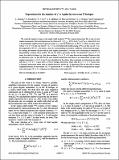Por favor, use este identificador para citar o enlazar a este item:
http://hdl.handle.net/10261/15494COMPARTIR / EXPORTAR:
 SHARE SHARE
 CORE
BASE CORE
BASE
|
|
| Visualizar otros formatos: MARC | Dublin Core | RDF | ORE | MODS | METS | DIDL | DATACITE | |

| Título: | Expressions for the number of J=0 pairs in even-even Ti isotopes |
Autor: | Zamick, L.; Escuderos, Alberto CSIC; Lee, S. J.; Mekjian, A. Z.; Moya de Guerra, Elvira CSIC ORCID; Raduta, A. A.; Sarriguren, Pedro CSIC ORCID | Palabras clave: | [PACS] Relation with nuclear matrix elements and nuclear structure [PACS] Nuclear structure models and methods [PACS] Properties of specific nuclei listed by mass ranges: 39 ≤ A ≤ 58 |
Fecha de publicación: | 28-mar-2005 | Editor: | American Physical Society | Citación: | Physical Review C 71(3): 034317 (2005) | Resumen: | We count the number of pairs in the single-j-shell model of 44Ti for various interactions. For a state of total angular momentum I, the wave function can be written as Ψ=∑JPJND(JPJN)[(j2)JP(j2)JN]I, where D(JPJN) is the probability amplitude that the protons couple to JP and the neutrons to JN. For I=0 there are three states with (I=0, T=0) and one with (I=0, T=2). The latter is the double analog of 44Ca. In that case (T=2), the magnitude of D(JJ) is the same as that of a corresponding two-particle coefficient of fractional parentage. In counting the number of pairs with an even angular momentum J, we find a new relationship is obtained by diagonalizing a unitary nine-j symbol. We are also able to get results for the “no-interaction” case for T=0 states, for which it is found, e.g., that there are fewer (J=1, T=0) pairs than on the average. Relative to this no-interaction case, we find that for the most realistic interaction used there is an enhancement of pairs with angular momentum J=0,2,1, and 7, and a depletion for the others. Also considered are interactions in which only the (J=0, T=1) pair state is at lower energy, interactions where only the (J=1, T=0) pair state is lowered, interactions where both are equally lowered, and the Q·Q interaction. We are also able to obtain simplified formulas for the number of J=0 pairs for the I=0 states in 46Ti and 48Ti by noting that the unique state with isospin |Tz|+2 is orthogonal to all the states with isospin |Tz|. | Descripción: | 8 pages, 3 tables, 1 appendix.-- PACS nrs.: 23.40.Hc; 21.60.-n; 27.40.+z.-- ArXiv pre-print available at: http://arxiv.org/abs/nucl-th/0501069v3 | Versión del editor: | http://link.aps.org/doi/10.1103/PhysRevC.71.034317 | URI: | http://hdl.handle.net/10261/15494 | DOI: | 10.1103/PhysRevC.71.034317 | ISSN: | 0556-2813 | E-ISSN: | 1089-490X |
| Aparece en las colecciones: | (CFMAC-IEM) Artículos |
Ficheros en este ítem:
| Fichero | Descripción | Tamaño | Formato | |
|---|---|---|---|---|
| expressions.pdf | 129,38 kB | Adobe PDF |  Visualizar/Abrir |
CORE Recommender
SCOPUSTM
Citations
9
checked on 24-abr-2024
WEB OF SCIENCETM
Citations
10
checked on 26-feb-2024
Page view(s)
289
checked on 24-abr-2024
Download(s)
84
checked on 24-abr-2024
Google ScholarTM
Check
Altmetric
Altmetric
NOTA: Los ítems de Digital.CSIC están protegidos por copyright, con todos los derechos reservados, a menos que se indique lo contrario.
